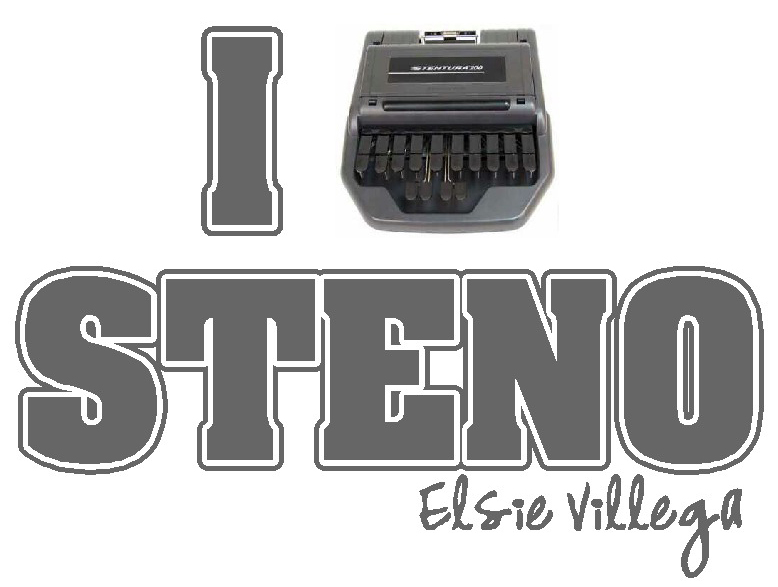Case CATalyst: Assigning Due Dates To Jobs
Case CATalyst: How To Build A Concordance Index
Writing Colloquy For The Witness
 How do you write colloquy for the witness on your machine? Here are a couple of suggestions. Lately, I’ve been favoring the second option.
How do you write colloquy for the witness on your machine? Here are a couple of suggestions. Lately, I’ve been favoring the second option.
Machine Briefs:
OPTION #1:
OPTION #2:
When D-defining colloquy for the witness, don’t forget to add a space after the colon so the colloquy designation translates with two spaces after the colon.
Case CATalyst: Bench Mode
 Bench mode in Case CATalyst allows the stenographer to write without showing the translating text to any realtime recipients. Only the stenographer will be able to see the translation. Bench mode can be toggled on and off.
Bench mode in Case CATalyst allows the stenographer to write without showing the translating text to any realtime recipients. Only the stenographer will be able to see the translation. Bench mode can be toggled on and off.
Machine Briefs:
OPTION #1: {Toggle Bench Mode}= B*EN/B*EN
OPTION #2: {Toggle Bench Mode}= B*EFP/B*EFP
Case CATalyst: The Scan Define Command
 The scan define command in Case CATalyst allows you to fix the last untranlate/mistranslate in your translating file via your steno machine. This command eliminates the necessity of having to remove your hands from your steno machine to use your computer keyboard to correct an untranslated/mistranslate.
The scan define command in Case CATalyst allows you to fix the last untranlate/mistranslate in your translating file via your steno machine. This command eliminates the necessity of having to remove your hands from your steno machine to use your computer keyboard to correct an untranslated/mistranslate.
The scan define command can be defined in your Realtime Commands Dictionary or any other dictionary. The recommended dictionary entry is as follows: SKAN/SKAN= {Scan Define}
Writing the steno on your machine that activates the scan define command will open a power define dialog box which contains last untranslated/mistranslate in the steno field. You can then input your desired action for the edit sought.
Case CATalyst: Don’t Just Backup Your Dictionary, Also Backup Your System Files Case
 System files is a key component to the operation of Case CATalyst software. Without system flies, you will not be able to translate, edit, read, or print a transcript via Case CAT.
System files is a key component to the operation of Case CATalyst software. Without system flies, you will not be able to translate, edit, read, or print a transcript via Case CAT.
Each Case CATalyst user must have one system files case in order to properly operate the software.
The system files case contains: User setting files, dialog settings, keyboard maps, your personal dictionary, index templates (for automatic indexing), layouts case, realtime commands, conflict database, phonetic table, power define codes, EZ speaker codes, and your personal word list.
Due to containing all of the aforementioned pertinent information, it would be wise to periodically backup your system files.
Case CATalyst: Analysis Of Transcript For Brief Suggestions
 Transcript Brief It is a Case CATalyst function that will analyze your transcript and suggest briefs that will be added to your Brief It pane. This feature only works with transcripts that have text associated with steno. (There is another comparable function that can be used with text-only files). (1) Open your job in Translate & Edit or Edit text. (2) Click Global, Transcript Brief It (or press Alt + g, b). (3) At, “This will fill your Brief It list after analyzing the whole transcript. Continue?” Click Yes to continue, or No to cancel. (NOTE: Once you start analyzing the transcript, you can’t cancel.)
Transcript Brief It is a Case CATalyst function that will analyze your transcript and suggest briefs that will be added to your Brief It pane. This feature only works with transcripts that have text associated with steno. (There is another comparable function that can be used with text-only files). (1) Open your job in Translate & Edit or Edit text. (2) Click Global, Transcript Brief It (or press Alt + g, b). (3) At, “This will fill your Brief It list after analyzing the whole transcript. Continue?” Click Yes to continue, or No to cancel. (NOTE: Once you start analyzing the transcript, you can’t cancel.)
Case CATalyst: The Orphan Control Format Symbol
 The Orphan Control format symbol is inserted when you want to keep lines of text together and not have the lines of text separated by page breaks. When you use the Orphan Control format symbol, you will be asked to specify the number of lines you want to keep together.
The Orphan Control format symbol is inserted when you want to keep lines of text together and not have the lines of text separated by page breaks. When you use the Orphan Control format symbol, you will be asked to specify the number of lines you want to keep together.
The Orphan Control format symbol can be added to dictionary entries and include files. It can also be utilized when editing.
It should be noted that the Orphan Control format symbol’s options can also be set to insert text or characters on the blank lines. These characters or letters can be a way to show that the lines were left blank intentionally.
The Color Codes For Case CATalyst’s Job Folders
 The state of your jobs can be identified by color coded job folders.
The state of your jobs can be identified by color coded job folders.
By default, the color codes for the job folders are as follows:
Yellow= Steno that has been read but not translated.
Pink= Jobs that have been translated or in progress in edit.
Blue= Jobs that have been assigned to the proofreader or are in final edit.
Brown= Job has been printed.
Black= Jobs in the completed or done state.
Green= Job has been exported to ASCII.
